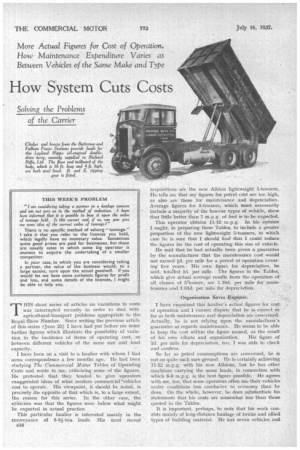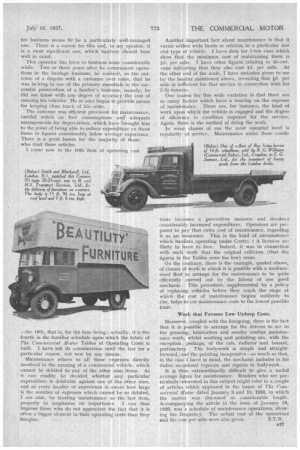More Actual Figures for Cost of Operation. How Maintenance Expenditure Varies as Between Vehicles of the Same Make and Type
Page 50

Page 51

If you've noticed an error in this article please click here to report it so we can fix it.
How System Cuts Costs
Solving the Problems of the Carrier THIS short series of articles on variations in costs was interrupted recently in order to deal with agricultural-transport problems appropriate to the Royal Show Number. Since writing the previous article of this series (June 25) I have had put before me some further figures which illustrate the possibility of variation in the incidence of items of operating cost, as between different vehicles of the same size and load
capacity. ,
I have been on a visit to a haulier with whom I had some correspondence a few months ago. He had been studying The Commercial Motor Tables of Operating Costs and wrote to me, criticizing some of the figures. He protested that they tended to give operators exaggerated ideas of what modern commercial vehicles cost to operate. His viewpoint, it should be noted, is precisely the opposite of that which is, to a large extent, the reason for this series. In the other case, the criticism was that the figures were below what might be expected in actual practice.
This particular haulier is interested mainly in the conveyance of 5-51-ton loads. His most recent ii16
acquisitions are the new Albion lightweight 5-tonners. He tells me that my figures for petrol cdst are too high, as also are those for maintenance and depreciation. Average figures for 5-tonners, which must necessarily include a majority of the heavier types of vehicle, show that little better than 7 m.p.g. of fuel is to be expected.
This operator obtains 11-12 m.p.g. In his opinion I ought, in preparing these Tables, to include a greater proportion of the new lightweight 5-tormers, in which case he is sure that I should find that I could reduce the figures for the cost of operating this size of vehicle.
He said that he had actually been given a guarantee , by the manufacturer that the maintenance cost would not exceed id. per mile for a period of operation covering five years. His own figure for depreciation, he said, totalled id. per mile. The figures in the Tables, which give actual average results from the operation of all classes of nonner, are 1.10th per mile for maintenance and 1.01d. per mile for depreciation.
Organization Saves Expense.
I have examined this haulier's actual figures for cost, of operation and I cannot dispute that he is correct so far as both maintenance and depreciation are concerned. Actually, he is not relying upon the manufacturer's guarantee as regards maintenance. He seems to be able to keep the cost within the figure named, as the result
of his own efforts and organization. His figure of Id. per mile for depreciation, too, I was able to check and confirm.
So far as petrol consumptions are concerned, he is not on quite such sure ground. He is certainly achieving 11-12 m.p.g. with his new Albions, but he has other machines carrying the same loads, in connection with which 8-9 m.p.g. is the best figure possible. He agrees with me, too, that some operators often use their vehicles under conditions less conducive to economy than be does. On the whole, however, he does substantiate his statements that his costs are somewhat less than those quoted in the Tables.
It is important, perhaps, to note that his work consists mainly of long-distance haulage of bricks and allied types of building material. He has seven vehicles and his business seems tb•-• be a particularly well-managed one. There is a reason for this and, in my opinion, it is a most significant one; which hauliers should bear well in mind.
This operator has been in business some considerable while. Two or three years after he commenced operations in the haulage business, he realized, as the outcome of a dispute with a customer over rates, that he was lacking in one of the primary essentials to the successful prosecution of a haulier's business, namely, he did not know With any degree of accuracy the cost of running his vehicles He at once began to provide means for keeping close track of his cdsts.
2..The Outcome was efficient provision for maintenance, careful watch on fuel consumptions andadequate arrangements for depreciation, which have brought him to the point of being able to reduce expenditure on those items to figures considerably below average experience. There is a great lesson for the majority of those who read these articles.
I come now to the 10th item of operating cost
—the 10th, that is, for the time being: actually, it is the fourth in the familiar schedule upon which the fabric of The Commercial .Motor Tables of Operating Costs is built. I have left its consideration until the last for a particular reason, not new by any means.
Maintenance relates to all those expenses directly involved in the running of a commercial vehicle, which cannot be debited to any of the other nine items. As it can readily be decided whether any particular expenditure is debitable against one of the other nine, and as every haulier of experience is aware how large is the number of expenses which cannot be so debited, I am able, by treating maintenance asthe last item, properly to emphasize its importance. I can thus impress those who do not appreciate the fact that it is often a bigger Oen-lent in their operating costs than they imagine. Another important fact about maintenance is that it varies within wide limits in relation to a particular size and type of vehicle. I have data for 1.-ton vans which show that the minimum cost of maintaining them is d. per mile. I have other figures relating to 30-cwt. vans indicating that they also cost id. per mile. At the other end of the scale. I have statistics given to me by the haulier mentioned above, revealing that id. per mile is sufficient for that service in connection with his 5-51--tonners.
One reason for this wide variation is that there are so many factors which have a bearing on the expense of maintenance. There are, for instance, the kind of work upon which the vehicle is engaged and the degree of efficiency in condition required for the service. Again, there is the method of doing the work.
In sonic classes of use the most essential need is regularity of service. Maintenance under these cOndi tions becomes a preventive measure and involvea considerably increased expenditure. Operators are prepared to pay that extra cost of maintenance, regarding it as an insurance. This is the kind of circumstance which hauliers operating under Contra t A licences are likely to have to face. Indeed, it was in connection with such work that. the original criticism (that the figures in the Tables were too low) arose.
On the contrary, there is the example, quoted above, of classes of work in which it is possible with a mediumsized fleet to arrange for the maintenance to be quite efficiently carried out by the labour of one good mechanic. This procedure, supplemented by a policy of replacing vehicles before they reach the stage at which the cost of maintenance begins . suddenly to rise, helps to cut maintenance costs to the lowest possible Work that Favours Low Upkeep Costs.
Moreover, coupled with the foregoing, there is the fact that it is possible to arrange for the drivers to see to the greasing, lubrication and sundry routine maintenance work, whilst washing and polishing are, with the exception, perhaps, of the cab, radiator and bonnet, perfunctory. The bodywork is simple and straightforward, and the painting inexpensive—so much so that, in the case I have in mind, the mechanic includes in his duties occasional repaints and repairs to bodywork.
It is thus extraordinarily difficult to give a useful average figure for maintenance. Readers who are particularly interested in this subject might refer to a couple of articles which appeared in the issues of The Commercial Motor dated January 3 and 10, 1936, in which the matter was discussed at considerable length. Accompanying the article in the issue of January 10, 1936, was a schedule of maintenance operations, showing the frequency. The actual cost of the operations and the cost per mile were also given. S.T.R.




























































































